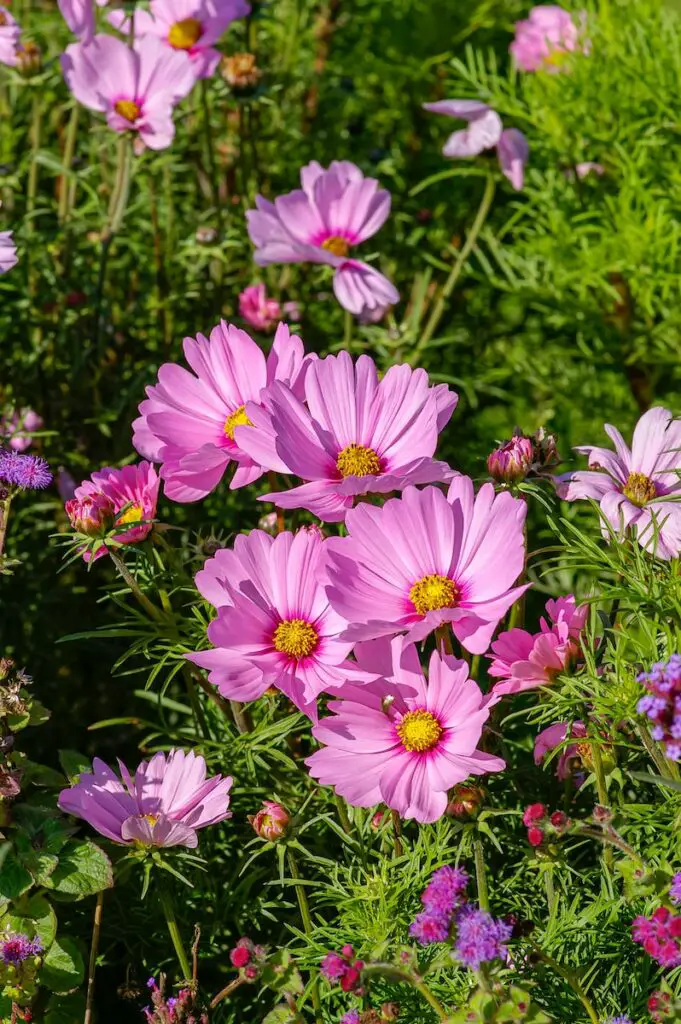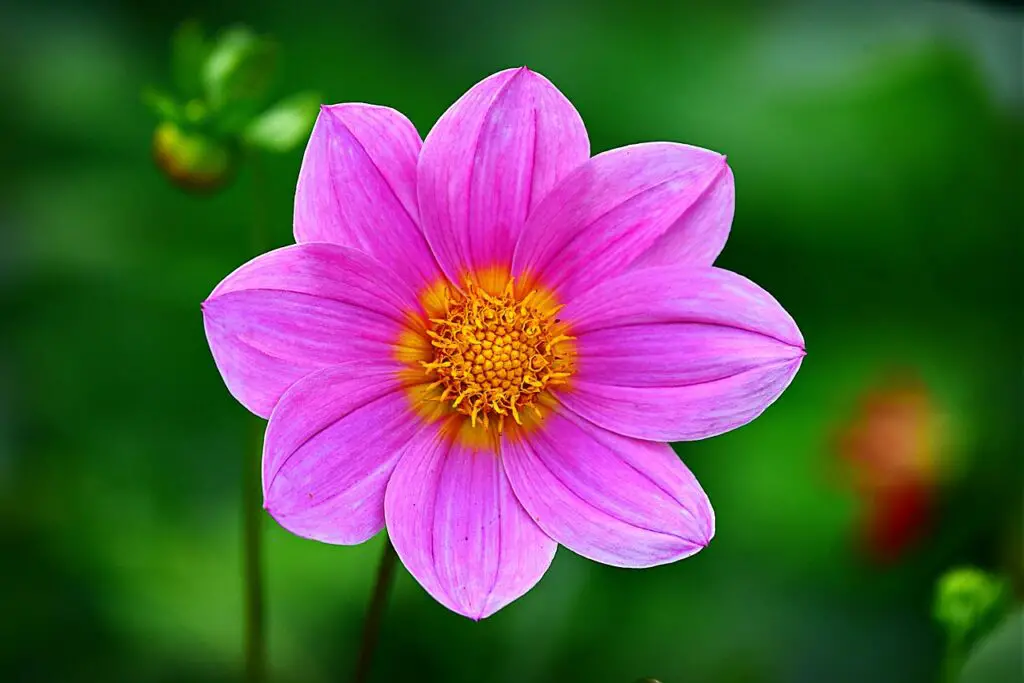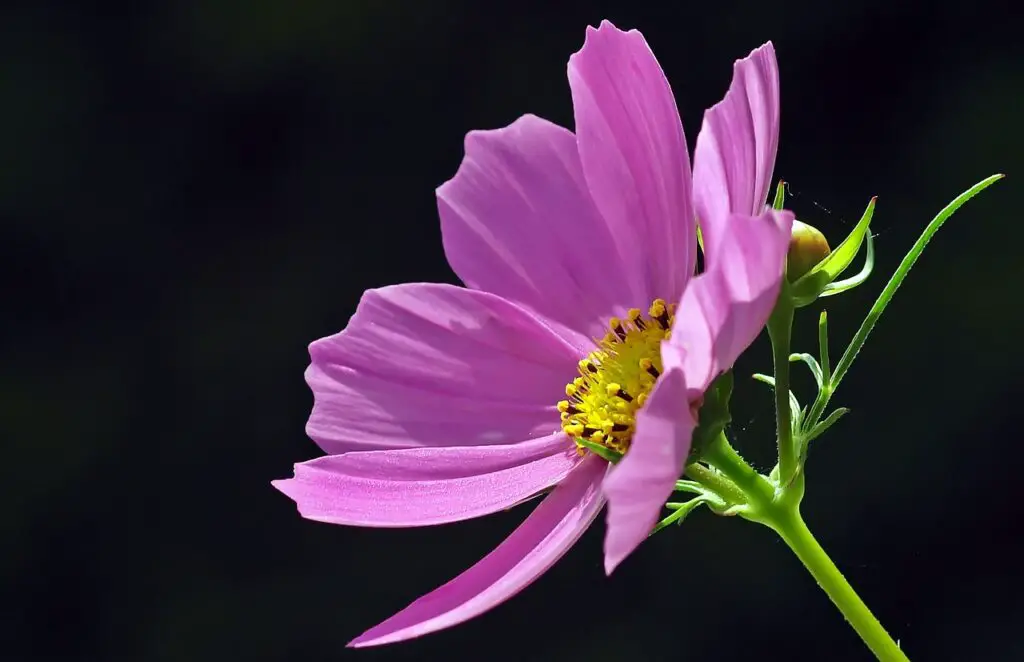
Deer are known for their voracious appetite, and gardeners often find themselves wondering what plants they will or will not eat. One such plant that gardeners may be curious about is the cosmos flower. Cosmos are popular garden flowers that come in a range of colors, and they are often planted in large groups to create a stunning visual display. However, some gardeners may be hesitant to plant cosmos if they are unsure whether deer will eat them.
Fortunately, the answer is relatively straightforward. Deer do eat cosmos, but they are not typically one of the deer’s preferred foods. While deer will eat almost any plant if they are hungry enough, cosmos are not at the top of their list. That being said, if there is a shortage of food in the area, deer may turn to cosmos as a food source. Additionally, younger plants may be more vulnerable to deer browsing than older, established plants.
Table of Contents
Understanding Cosmos

Cosmos is a genus of flowering plants that belong to the Asteraceae family. They are native to Mexico, Central America, and South America. Cosmos plants are known for their tall, slender stems and beautiful flowers. There are several varieties of cosmos, including Cosmos bipinnatus, Cosmos sulphureus, and Mexican cosmos.
Cosmos bipinnatus is the most commonly grown variety of cosmos. It can grow up to 6 feet tall and produces large, daisy-like flowers in shades of pink, white, and red. Cosmos bipinnatus is an annual plant, which means it completes its life cycle in one growing season.
Cosmos sulphureus, also known as yellow cosmos, is another popular variety of cosmos. It is shorter than Cosmos bipinnatus, growing up to 3 feet tall. Cosmos sulphureus produces bright yellow and orange flowers and is also an annual plant.
Mexican cosmos, also known as Cosmos atrosanguineus, is a perennial plant that is native to Mexico. It grows up to 3 feet tall and produces dark red or maroon flowers. Mexican cosmos is known for its chocolate-scented flowers, which make it a popular choice for gardeners.
Garden cosmos, also known as Cosmos bipinnatus, is a versatile plant that can be grown in a variety of soil types and conditions. It is easy to grow from seed and can be used as a border plant, in containers, or as a cut flower.
In conclusion, cosmos plants are a beautiful addition to any garden. With their tall, slender stems and colorful flowers, they are sure to add a touch of elegance to any landscape. Whether you choose Cosmos bipinnatus, Cosmos sulphureus, or Mexican cosmos, you can be confident that you are adding a stunning plant to your collection.
Deer and Their Eating Habits

Deer are known to be herbivores, which means that they feed on plants. They are found in different habitats, including woodlands, forests, and open fields. Deer are known to have a significant impact on the vegetation in their habitat, especially during the winter months when food sources are limited.
Doe and fawns are known to be more selective in their feeding habits, while bucks are known to be less selective. Deer are opportunistic feeders and will eat what is available to them. This includes flowers, leaves, stems, and even bark.
Deer are known to cause significant damage to gardens and crops, including cosmos. Cosmos is a popular garden flower that is known for its vibrant colors and delicate petals. While deer do not prefer cosmos, they will eat them if there is nothing else available.
To prevent deer from eating cosmos, gardeners can use various methods, including:
- Fencing: A fence is an effective way to keep deer out of a garden. The fence should be at least 8 feet high and made of a material that deer cannot jump over or through.
- Repellents: There are various deer repellents available in the market that can be sprayed on plants. Repellents can be effective, but they need to be reapplied regularly.
- Planting deer-resistant plants: Planting deer-resistant plants can be an effective way to prevent deer from eating cosmos. Some examples of deer-resistant plants include lavender, sage, and yarrow.
In conclusion, deer are herbivores that feed on plants, including cosmos. While they do not prefer cosmos, they will eat them if there is nothing else available. Gardeners can use various methods, including fencing, repellents, and planting deer-resistant plants, to prevent deer from eating cosmos.
Cosmos as Deer Resistant Plants

Cosmos are a popular choice for many gardeners due to their bright colors and easy care. However, one concern that gardeners often have is whether or not deer will eat their cosmos.
Fortunately, cosmos are generally considered to be deer resistant plants. While no plant is completely deer-proof, cosmos have a few characteristics that make them less attractive to deer.
First, cosmos have a strong scent that deer tend to avoid. Additionally, their foliage is somewhat prickly, which can make them less appealing to deer as a food source. Finally, cosmos are not typically a preferred food source for deer, who tend to prefer plants like hostas and daylilies.
While it’s always possible that a particularly hungry deer may decide to nibble on your cosmos, most gardeners find that their cosmos are left alone by deer.
Overall, if you’re looking for a colorful and easy-care plant that is also deer resistant, cosmos are a great choice.
Natural Deer Repellents

Deer can be a nuisance for gardeners, especially when it comes to protecting delicate plants. While there are many commercial deer repellents available, some people prefer to use natural methods to keep deer at bay. Here are some natural deer repellents that can be effective:
Fragrant Herbs and Plants
Deer have a strong sense of smell, and there are many fragrant herbs and plants that they find unappealing. Some of these include:
- Lavender: Deer dislike the strong aroma of lavender, making it an effective natural repellent.
- Sage: The strong scent of sage can also be effective in keeping deer away.
- Chives: Chives have a strong onion-like smell that deer find unappealing.
- Garlic: Garlic has a strong odor that deer do not like.
- Rosemary: The strong scent of rosemary can be effective in repelling deer.
Other Natural Repellents
In addition to fragrant herbs and plants, there are other natural repellents that can be effective in keeping deer away. These include:
- Soap: Hanging bars of soap in the garden can be effective in repelling deer. The strong smell of the soap can be enough to keep them away.
- Human hair: Sprinkling human hair around the garden can also be effective. The scent of human hair can be enough to deter deer.
- Predator urine: Using predator urine, such as coyote or fox urine, can be effective in keeping deer away. The scent of a predator can be enough to scare them off.
While natural deer repellents can be effective, it is important to note that they may not work for all deer and in all situations. It may be necessary to use a combination of methods to keep deer away from delicate plants.
Protecting Cosmos from Deer

Cosmos are beautiful flowers that attract many pollinators to your garden. Unfortunately, deer also find them delicious and can quickly destroy your cosmos plants. Here are some ways to protect your cosmos from deer:
Fencing
One effective way to keep deer away from your cosmos is to install a fence around your garden. A fence that is at least 8 feet tall is recommended to keep deer from jumping over it. Additionally, the fence should be sturdy and have no gaps or holes that deer can squeeze through.
Physical Barrier
If a fence is not an option, you can also try using physical barriers to protect your cosmos. This could include placing netting or chicken wire around your plants, or using individual plant covers made from mesh or fabric.
Protecting Your Cosmos
Another way to protect your cosmos from deer is to make them less attractive to the animals. This can be done by planting other plants that deer do not like nearby, or by using deer repellents on and around your cosmos plants.
Location
Choosing the right location for your cosmos can also help to deter deer. Planting them in a location that is not easily accessible to deer, such as on a hill or in a raised garden bed, can help to keep them safe.
Sunlight
Finally, making sure your cosmos plants get enough sunlight can also help to deter deer. Deer are more likely to feed on plants that are in shady areas, so planting your cosmos in a sunny location can make them less attractive to the animals.
By using one or more of these methods, you can help to protect your cosmos from deer and enjoy their beautiful blooms all season long.
Alternative Plants Deer Avoid
Deer can be quite destructive to gardens and flower beds, but there are some plants that they tend to avoid. If you’re looking for alternatives to cosmos that won’t attract deer, consider the following options:
- Prickly plants: Deer tend to avoid plants with thorns or prickly leaves, as they can be uncomfortable to eat or walk through. Consider planting prickly pear cactus, holly, or barberry bushes.
- Aster: Asters are a beautiful fall-blooming flower that deer tend to avoid. They come in a variety of colors and can be planted in both sun and shade.
- Chocolate cosmos: While deer may be attracted to regular cosmos, they tend to avoid chocolate cosmos. These dark brown flowers have a rich, chocolatey scent that humans love but deer don’t seem to care for.
- Marigolds: Marigolds are a popular choice for gardeners looking to repel pests, including deer. They have a strong scent that can be unpleasant to deer and other animals.
- Larkspur: Larkspur is a tall, spiky flower that deer tend to avoid. They come in a variety of colors and can add height and texture to your garden.
- Flowering tobacco: While tobacco is typically associated with smoking, flowering tobacco is a beautiful plant that deer tend to avoid. It has trumpet-shaped flowers in shades of pink, white, and purple.
- Bee balm: Bee balm, also known as monarda, is a native North American plant that deer tend to avoid. It has bright, showy flowers in shades of pink, red, and purple.
- Boxwood: Boxwood is a popular choice for hedges and topiaries, and it’s also a plant that deer tend to avoid. It has small, glossy leaves that can add texture and structure to your garden.
- Michael: Michaelmas daisies, also known as asters, are a fall-blooming flower that deer tend to avoid. They come in a variety of colors and can add a pop of color to your garden.
- Azalea: Azaleas are a popular flowering shrub that deer tend to avoid. They have bright, showy flowers in shades of pink, red, and white.
- Bearded iris: Bearded iris is a tall, elegant flower that deer tend to avoid. They come in a variety of colors and can add height and texture to your garden.
- Butterfly bush: Butterfly bush, also known as buddleia, is a popular choice for attracting butterflies to your garden. It’s also a plant that deer tend to avoid.
- Cineraria: Cineraria is a small, daisy-like flower that deer tend to avoid. They come in a variety of colors and can be planted in both sun and shade.
- Red twig dogwood: Red twig dogwood is a shrub that’s prized for its bright red stems in the winter. It’s also a plant that deer tend to avoid.
- Purple coneflower: Purple coneflower, also known as echinacea, is a popular choice for attracting pollinators to your garden. It’s also a plant that deer tend to avoid.
Growing Conditions for Cosmos
Cosmos are a popular garden flower known for their bright colors and delicate appearance. They are easy to grow and care for, making them a favorite among gardeners of all levels of experience.
Soil
Cosmos grow best in well-drained soils that are rich in organic matter. They can tolerate a wide range of soil types, but they prefer a slightly acidic soil with a pH between 6.0 and 7.0. If the soil is too compacted or heavy, it can lead to poor drainage and root rot. Adding compost or other organic matter to the soil can help improve its texture and fertility.
Water
Cosmos are drought-tolerant plants, but they still need regular watering to thrive. During periods of drought, it is important to water them deeply and infrequently to encourage deep root growth. Overwatering can lead to root rot and other diseases, so it is important to avoid watering too frequently or too heavily.
Fertilizer
Cosmos do not require a lot of fertilizer to grow, but they do benefit from regular applications of a balanced, all-purpose fertilizer. It is best to fertilize them once a month during the growing season, starting in the spring and continuing through the summer. Avoid overfertilizing, as this can lead to excessive growth and weaker stems.
Poisonous
Cosmos are not poisonous to humans or animals, making them a safe choice for gardens and landscapes. However, they can be toxic to some insects, including bees and butterflies. If you are concerned about the impact of pesticides on these pollinators, it is best to avoid using them on or near your cosmos plants.
In summary, growing cosmos is a simple and rewarding experience. With the right growing conditions, these beautiful flowers can thrive in any garden or landscape.
Winter Care for Cosmos
Cosmos plants are generally easy to care for, but they do require some attention during the winter months to ensure their survival. Here are a few tips for winter care of cosmos:
Yellowing of Leaves
If you notice yellowing of leaves on your cosmos plant, it could be a sign of overwatering or nutrient deficiency. During the winter months, it is important to reduce watering frequency as the soil takes longer to dry out. Additionally, adding a balanced fertilizer to the soil can help provide the necessary nutrients for the plant.
Protection from Frost
Cosmos plants are not frost-tolerant, so it is important to protect them from freezing temperatures. Covering the plants with a frost cloth or blanket can help keep them warm. Alternatively, you can move potted cosmos plants indoors to protect them from the cold.
Pruning
Pruning your cosmos plants can help promote healthy growth and prevent disease. During the winter months, it is a good idea to remove any dead or diseased branches from the plant. Additionally, pruning can help control the size and shape of the plant.
Mulching
Mulching around the base of your cosmos plant can help insulate the soil and protect the roots from freezing temperatures. A layer of organic mulch, such as shredded leaves or straw, can also help retain moisture in the soil.
Overall, winter care for cosmos plants involves reducing watering frequency, protecting from frost, pruning, and mulching. By following these tips, you can help ensure the survival of your cosmos plants during the winter months.